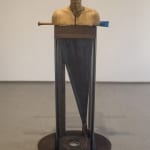Vytautas Viržbickas Lithuanian, b. 1987
Sveikinimai. Žinoti skirtumus tarp intelekto ir jėgos, ir kuris iš jų teikia didžiausią malonumą / Congrats. To know the difference between intellect and power, as well as which one is more satisfying, 2016
Degintas lakuotas plienas, varis, ąžuolas, degintas ąžuolas, beisbolo lazda, stiklų tamsinimo plėvelė, tušas / Burnt lacquered steel, copper, oak, burnt oak, baseball bat, window tinting film, ink.
Kintami matmenys / Dimensions variable
Further images
Even though the work resembles a construct of myth it is not meant to illustrate a pre-existing mythic image or narrative but rather to reflect my individual notion of the...
Even though the work resembles a construct of myth it is not meant to illustrate a pre-existing mythic image or narrative but rather to reflect my individual notion of the concept – in his email to art gallery “Vartai” writes artist Vytautas Viržbickas.
In V. Viržbickas’s artistic practice “myth” is an ambivalent concept. The great majority of the artist’s works (amongst which most recent ones Sounds Like Occupation (2015) and Relax. It‘s A Time Of Peace. Enjoy The Moment (2015)) requires viewer’s perception of artistic, historic and social contexts. However, the aesthetic force of V. Viržbickas’s artworks more often than not is being generated by him purposefully rejecting tradition and canon and is inherent to the artist’s zealous urge to introduce and interpret contemporary sculpture in a broad social discourse of the XXI century.
In addition, V. Viržbickas strives to shape his artistic personality by actively avoiding the label “artist-mythologist” which is being put on him by the local art commentators and critics. The sculptural work To know the difference between intellect and power as well as which one is more satisfying is complex not only in terms of its form and chose of materials but also its ideology and represents V. Viržbickas’s artistic attitude in the current artistic climate.
The four-legged bust is a contemporary centaur. The mythological being can be read as an epitome of history – it cradles in itself a multiplicity of contexts relating to time, space, form and narrative. Therefore, it can be fruitfully interpreted in relation to theoretical discourses such as Michel Foucault’s ideas of heterotopia and heterochrony. Moreover, the sculpture is built around a bust that is also the artist’s self-portrait. Its imaginary nose is eagerly pointing the spectator towards an image of a half-man, half-lion – a sphinx. V. Viržbickas is juggling various sculptural canons, he consciously plucks the strings of art history leaving his song to linger in the air and asking the viewer to listen up.
Vytautas himself, on the other hand, is a 27-year-old bloke from Panevėžis. In his teens he had to walk the streets of one of the most dangerous cities in Lithuania where he would, literally, be hit in the nose. The two strands – the centaur’s rugged metal hooves and tender curves of the author’s wooden bust – intertwine forming DNA of V. Viržbickas’s own mythological makeup.
Therefore, in this work V. Viržbickas activavely and dinamically (and at the same time somewhat sentimentally and perhaps even comically) cultivates two separate mythologies: the “real” one (Ancient Greece) and the pseudo one (Contemporary Panevėžys). Working along the lines of those two mythologies the artist contemplates the concept of masculinity in today’s low culture which he feels and admits, although not directly, to be a part of.
The combat skills that he inherited from tribes of chavs of his local city allows the artist to delve deep into the social genetics of the young people that were raised in Lithuania in the 90s. To V. Viržbickas this genetical code is an inexhaustible torrent containing images, places and narratives which is fluid and free-flowing as the blood gushing from the centaur’s broken nose.
One is able to find snippets of these “tales of masculinity” in the work. They are represented by individual artifacts: V. Viržbickas’s oaken self-portrait which a few years after its execution was accidentally damaged by the artist himself leaving the bust with a disfigured nose; a rose blossom carved from a baseball bat which the artist created after seeing a spectacle in Vilnius one evening – a group of pumped up aggressively looking fellows carrying red roses wrapped in cellophane; finally, elements of manly attire – for example, striped tracksuit trousers which not only represent a particular (sub)culture but also, according to the artist, remind combat attributes, such as blades and armor, which may be directly associated with the display of power.
In the context of contemporary art scene V. Viržbickas like his battered-nose centaur is encircled in a hermetic space and stands alone. The artist is both: an aggressor and a victim. The savage artistic style separates him from the pack of young emerging artists who use refined minimalist techniques and forces him to wander through the modern wasteland in the age of post-internet art. It is from here that he sends us his bloody regards.
In V. Viržbickas’s artistic practice “myth” is an ambivalent concept. The great majority of the artist’s works (amongst which most recent ones Sounds Like Occupation (2015) and Relax. It‘s A Time Of Peace. Enjoy The Moment (2015)) requires viewer’s perception of artistic, historic and social contexts. However, the aesthetic force of V. Viržbickas’s artworks more often than not is being generated by him purposefully rejecting tradition and canon and is inherent to the artist’s zealous urge to introduce and interpret contemporary sculpture in a broad social discourse of the XXI century.
In addition, V. Viržbickas strives to shape his artistic personality by actively avoiding the label “artist-mythologist” which is being put on him by the local art commentators and critics. The sculptural work To know the difference between intellect and power as well as which one is more satisfying is complex not only in terms of its form and chose of materials but also its ideology and represents V. Viržbickas’s artistic attitude in the current artistic climate.
The four-legged bust is a contemporary centaur. The mythological being can be read as an epitome of history – it cradles in itself a multiplicity of contexts relating to time, space, form and narrative. Therefore, it can be fruitfully interpreted in relation to theoretical discourses such as Michel Foucault’s ideas of heterotopia and heterochrony. Moreover, the sculpture is built around a bust that is also the artist’s self-portrait. Its imaginary nose is eagerly pointing the spectator towards an image of a half-man, half-lion – a sphinx. V. Viržbickas is juggling various sculptural canons, he consciously plucks the strings of art history leaving his song to linger in the air and asking the viewer to listen up.
Vytautas himself, on the other hand, is a 27-year-old bloke from Panevėžis. In his teens he had to walk the streets of one of the most dangerous cities in Lithuania where he would, literally, be hit in the nose. The two strands – the centaur’s rugged metal hooves and tender curves of the author’s wooden bust – intertwine forming DNA of V. Viržbickas’s own mythological makeup.
Therefore, in this work V. Viržbickas activavely and dinamically (and at the same time somewhat sentimentally and perhaps even comically) cultivates two separate mythologies: the “real” one (Ancient Greece) and the pseudo one (Contemporary Panevėžys). Working along the lines of those two mythologies the artist contemplates the concept of masculinity in today’s low culture which he feels and admits, although not directly, to be a part of.
The combat skills that he inherited from tribes of chavs of his local city allows the artist to delve deep into the social genetics of the young people that were raised in Lithuania in the 90s. To V. Viržbickas this genetical code is an inexhaustible torrent containing images, places and narratives which is fluid and free-flowing as the blood gushing from the centaur’s broken nose.
One is able to find snippets of these “tales of masculinity” in the work. They are represented by individual artifacts: V. Viržbickas’s oaken self-portrait which a few years after its execution was accidentally damaged by the artist himself leaving the bust with a disfigured nose; a rose blossom carved from a baseball bat which the artist created after seeing a spectacle in Vilnius one evening – a group of pumped up aggressively looking fellows carrying red roses wrapped in cellophane; finally, elements of manly attire – for example, striped tracksuit trousers which not only represent a particular (sub)culture but also, according to the artist, remind combat attributes, such as blades and armor, which may be directly associated with the display of power.
In the context of contemporary art scene V. Viržbickas like his battered-nose centaur is encircled in a hermetic space and stands alone. The artist is both: an aggressor and a victim. The savage artistic style separates him from the pack of young emerging artists who use refined minimalist techniques and forces him to wander through the modern wasteland in the age of post-internet art. It is from here that he sends us his bloody regards.
Exhibitions
2017. Kūnas ir tamsa, Galerija Vartai, Vilnius.Literature
Magasin – CNAC, 2013.
Access through internet: http://www.magasin-cnac.org/uploads/10_DossierP%C3%A9dagogique_VytautasVIRZBICKAS_new%20(1).pdf
Dr. Virginija Vitkienė: Triukšmingas žinomos istorijos užtildymas. Vytauto Viržbicko paroda Le Magasin šiuolaikinio meno centre, Grenoblyje, 2013.
Access through internet: http://artnews.lt/triuksmingas-zinomos-istorijos-uztildymas-vytauto-virzbicko-paroda-le-magasin-siuolaikinio-meno-centre-grenoblyje/
Eglė Mikalajūnė: Vytauto Viržbicko paroda galerijoje „Malonioji 6“, 2012.
Access through internet: http://artnews.lt/vytauto-virzbicko-paroda-galerijoje-malonioji-6/












